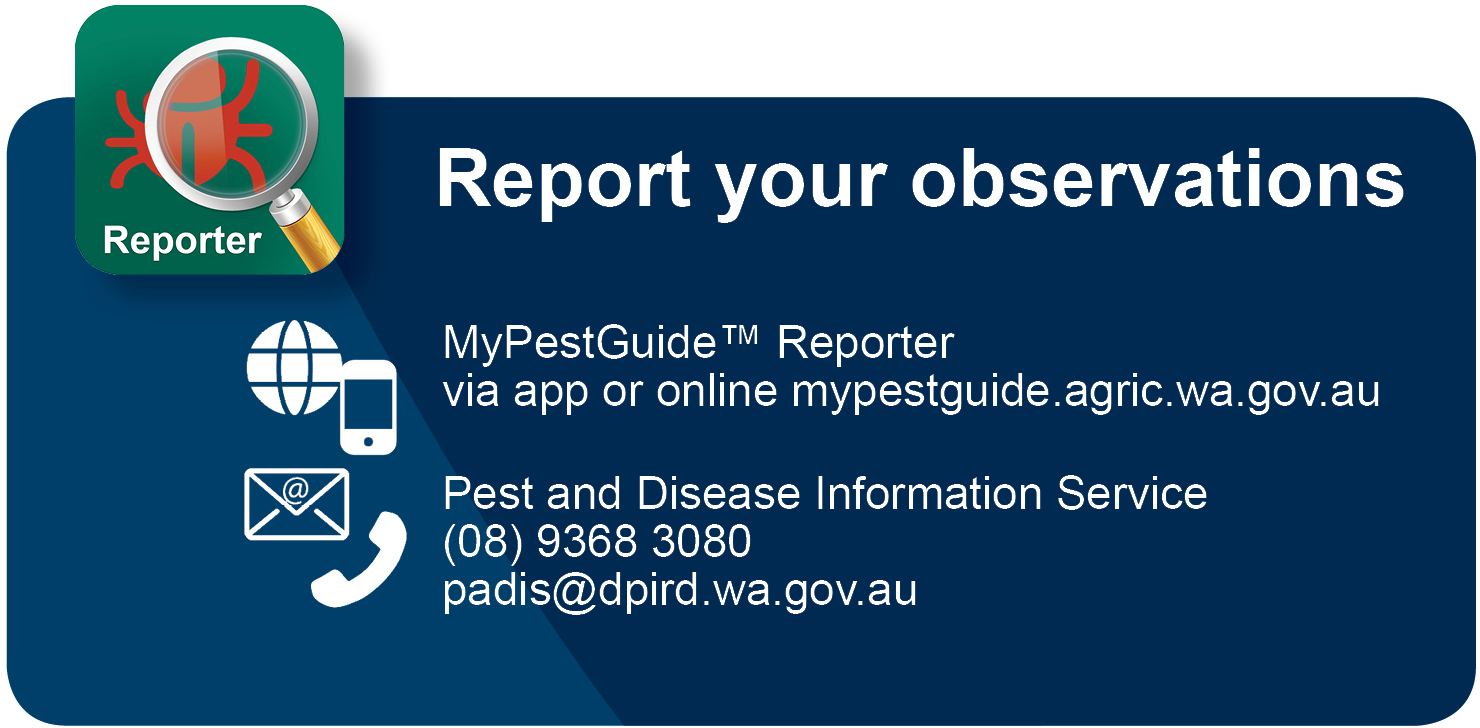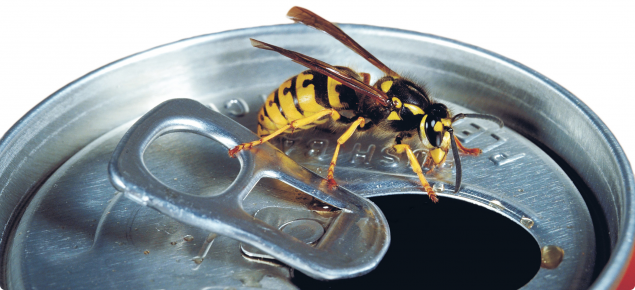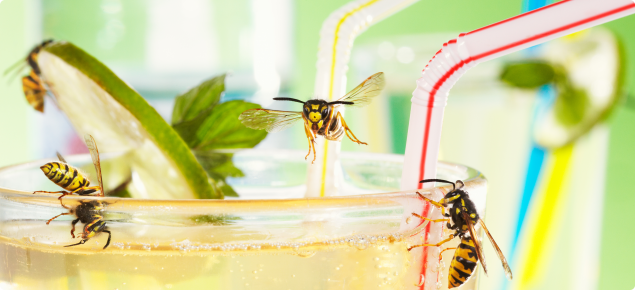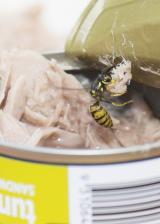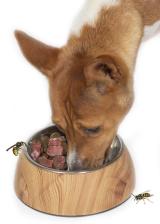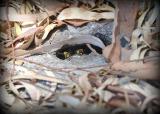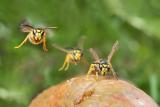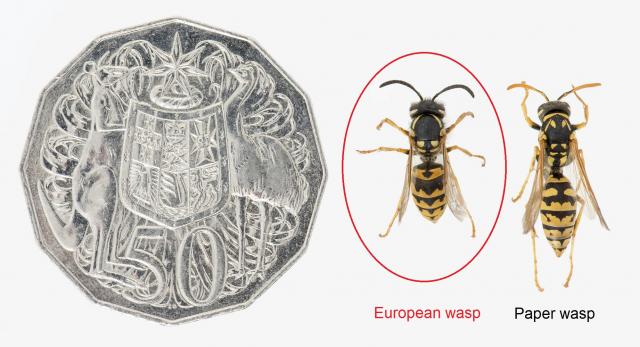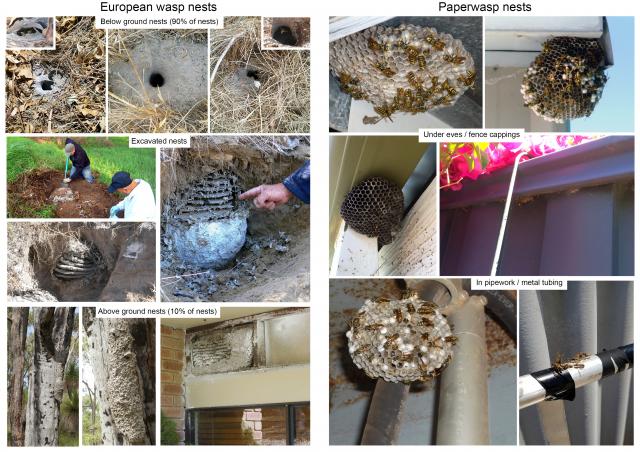Suspect European wasp sightings in Western Australia MUST BE REPORTED to the Department of Primary Industries and Regional Development.
Every year, fertilised European wasp queens are accidentally transported into our state in freight, cargo and vehicles from Eastern Australia. They must be detected and erradicated if we are to remain free of this pest.
Look for these distinctive characteristics
The European wasp has distinct behaviours among wasp species and other insects in Western Australia, which make it easier to identify.
Did you know that...
|
Similar looking insects
Because of their yellow and black stripes, several wasps, bees and flies can be mistaken for European wasps.
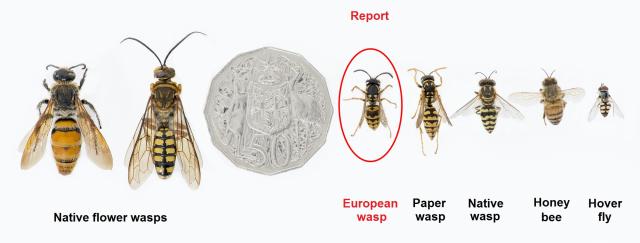
Native flower wasps (Families Tiphiidae and Scoliidae) are much larger. These harmless solitary wasps are beneficial pollinators. These solitary wasps only come together during the mating season.
Yellow paper wasps are bright yellow and black. Paper wasps differ being slightly longer and thinner (more wasp-like) and have orange-brown antennae. Unlike European wasps, paper wasps hover with their back legs hanging down.
Honey bees are about the same size as European wasps, but have black legs, are hairier and are dull brown-orange in colour, as opposed to bright yellow and black.
Native Bembix wasps are smaller than European wasps and their antennae are shorter and thinner and their eyes larger. In a lot of Bembix species, the eyes are a yellow-green and the body colour is closer to a lime-green yellow.
Hover flies are smaller than European wasps and they 'hover' when flying. Their antennae aren’t easily noticeable (very short and stubby) and their large eyes meet together. They have one pair of obvious wings as opposed to two pairs of the European wasp (large pair and short pair).
European wasp or yellow paper wasp?
Yellow paper wasps are easy to confuse with European wasps. They are very common and widespread in WA and are frequently seen nesting in guttering, under fence capping or attached to bushes. Paper wasps are often seen visiting flowers, ponds or water taps. Look for their distictive papery honeycomb nest, or note the colour of the antennae and the position of the legs when they fly.
Differences between European wasps and paper wasps
| European wasp | Paper wasp | |
|---|---|---|
| Size | Workers: about 15mm long (size of a bee) | 15–19mm long (longer than a bee) |
| Body shape | Stout body like a bee | Longer and thinner than a bee. Narrow waist |
| Colour | Bright yellow and black | |
| Antennae (feelers) | All black (see picture above) | Yellow-orange (see picture above) |
| Flying | Legs held close to body during flight. Fly very quickly, generally do not hover | Back legs dangle down during flight. Often seen hovering around bushes, over lawns and around water sources |
| Food | European wasps are scavengers feeding from pet food, meat or vegetable scraps, meat products, fish or dead insects | Paper wasps feed on insects including caterpillars, flies, beetle larvae and nectar |
Differences between European wasp and paper wasp nests
| European wasp nest | Paper wasp nest | |
|---|---|---|
| Nests | Rarely seen | Often seen. Usually above ground |
| Location | Usually below ground with the entrance appearing as a hole in the ground. On rare occasions they may be found in a roof or wall cavity. It will have a busy entrance hole with many wasps entering and exiting per minute | Under fence capping or roof tiles, also under eaves and in dense shrubs. Sometimes in hollow steel piping and guttering |
| Size | Large. Growing in summer to be the size of a basketball or bigger | Golf ball to crumpet sized. Rarely as big as a dinner plate |
| Shape | Round or football shaped with an outer covering of insulating material that looks like grey paper mache or egg carton material | Single flat layer of papery honeycomb cells. Grey-brown in colour, often with some white-capped cells |
| Note | REPORT - Do Not Treat | Follow paper wasp control instructions |
Sting first aid
For information on first aid treatment of wasp stings, please visit the Australian Health Direct website or contact the Western Australian Poisons Information Centre on 13 11 26.
Report
Report suspect sightings. In Western Australia, taking photos and submitting for identification via MyPestGuide™ Reporter or email them to PaDIS is the quickest avenue for ID. Alternatively, phone 08 9368 3080 to speak with our Pest and Disease Information Service.
NOTE: Your report should include: What you saw , where you saw it, and when it happened.
